Introduction to the Endocrine System
The endocrine system, along with the nervous system, functions in the regulation of body activities. The nervous system acts through electrical impulses and neurotransmitters to cause muscle contraction and glandular secretion. The effect is of short duration, measured in seconds, and localized. The endocrine system acts through chemical messengers called hormones that influence growth, development, and metabolic activities. The action of the endocrine system is measured in minutes, hours, or weeks and is more generalized than the action of the nervous system.There are two major categories of glands in the body - exocrine and endocrine.
Exocrine Glands
Exocrine glands have ducts that carry their secretory product to a surface. These glands include the sweat,sebaceous, and mammary glands and, the glands that secrete digestive enzymes.
Endocrine Glands
The endocrine glands do not have ducts to carry their product to a surface. They are called ductless glands. The word endocrine is derived from the Greek terms "endo," meaning within, and "krine," meaning to separate or secrete. The secretory products of endocrine glands are called hormones and are secreted directly into the blood and then carried throughout the body where they influence only those cells that have receptor sites for that hormone.Characteristics of Hormones
Chemical Nature of Hormones
Chemically, hormones may be classified as either proteins or steroids. All of the hormones in the human body, except the sex hormones and those from the adrenal cortex, are proteins or protein derivatives.Mechanism of Hormone
Action Hormones are carried by the blood throughout the entire body, yet they affect only certain cells. The specific cells that respond to a given hormone have receptor sites for that hormone. This is sort of a lock-and-key mechanism. If the key fits the lock, then the door will open. If a hormone fits the receptor site, then there will be an effect. If a hormone and a receptor site do not match, then there is no reaction. All the cells that have receptor sites for a given hormone make up the target tissue for that hormone. In some cases, the target tissue is localized in a single gland or organ. In other cases, the target tissue is diffuse and scattered throughout the body so that many areas are affected. Hormones bring about their characteristic effects on target cells by modifying cellular activity.Protein hormones react with receptors on the surface of the cell, and the sequence of events that results in hormone action is relatively rapid. Steroid hormones typically react with receptor sites inside a cell. Because this method of action actually involves synthesis of proteins, it is relatively slow.
Control of Hormone Action
Hormones are very potent substances, which means that very small amounts of a hormone may have profound effects on metabolic processes. Because of their potency, hormone secretion must be regulated within very narrow limits in order to maintain homeostasis in the body.Many hormones are controlled by some form of a negative feedback mechanism. In this type of system, a gland is sensitive to the concentration of a substance that it regulates. A negative feedback system causes a reversal of increases and decreases in body conditions in order to maintain a state of stability or homeostasis. Some endocrine glands secrete hormones in response to other hormones. The hormones that cause secretion of other hormones are called tropic hormones. A hormone from gland A causes gland B to secrete its hormone. A third method of regulating hormone secretion is by direct nervous stimulation. A nerve stimulus causes gland A to secrete its hormone.
Endocrine Glands & Their Hormones
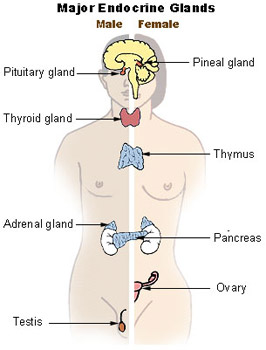 The endocrine system is made up of the endocrine glands that secrete hormones. Although there are eight major endocrine glands scattered throughout the body, they are still considered to be one system because they have similar functions, similar mechanisms of influence, and many important interrelationships.
The endocrine system is made up of the endocrine glands that secrete hormones. Although there are eight major endocrine glands scattered throughout the body, they are still considered to be one system because they have similar functions, similar mechanisms of influence, and many important interrelationships.Some glands also have non-endocrine regions that have functions other than hormone secretion. For example, the pancreas has a major exocrine portion that secretes digestive enzymes and an endocrine portion that secretes hormones. The ovaries and testes secrete hormones and also produce the ova and sperm. Some organs, such as the stomach, intestines, and heart, produce hormones, but their primary function is not hormone secretion.
Pituitary & Pineal Glands
Pituitary Gland
The pituitary gland or hypophysis is a small gland about 1 centimeter in diameter or the size of a pea. It is nearly surrounded by bone as it rests in the sella turcica, a depression in the sphenoid bone. The gland is connected to the hypothalamus of the brain by a slender stalk called the infundibulum.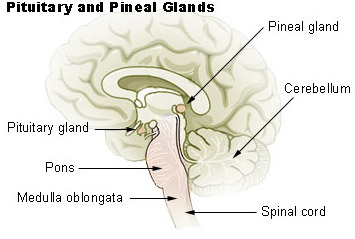 There are two distinct regions in the gland: the anterior lobe (adenohypophysis) and the posterior lobe (neurohypophysis). The activity of the adenohypophysis is controlled by releasing hormones from the hypothalamus. The neurohypophysis is controlled by nerve stimulation.
There are two distinct regions in the gland: the anterior lobe (adenohypophysis) and the posterior lobe (neurohypophysis). The activity of the adenohypophysis is controlled by releasing hormones from the hypothalamus. The neurohypophysis is controlled by nerve stimulation.Hormones of the Anterior Lobe (Adenohypophysis)
Growth hormone is a protein that stimulates the growth of bones, muscles, and other organs by promoting protein synthesis. This hormone drastically affects the appearance of an individual because it influences height. If there is too little growth hormone in a child, that person may become a pituitary dwarf of normal proportions but small stature. An excess of the hormone in a child results in an exaggerated bone growth, and the individual becomes exceptionally tall or a giant.Thyroid-stimulating hormone, or thyrotropin, causes the glandular cells of the thyroid to secrete thyroid hormone. When there is a hypersecretion of thyroid-stimulating hormone, the thyroid gland enlarges and secretes too much thyroid hormone.
Adrenocorticotropic hormone reacts with receptor sites in the cortex of the adrenal gland to stimulate the secretion of cortical hormones, particularly cortisol.
Gonadotropic hormones react with receptor sites in the gonads, or ovaries and testes, to regulate the development, growth, and function of these organs.
Prolactin hormone promotes the development of glandular tissue in the female breast during pregnancy and stimulates milk production after the birth of the infant.
Hormones of the Posterior Lobe (Neurohypophysis)
Antidiuretic hormone promotes the reabsorption of water by the kidney tubules, with the result that less water is lost as urine. This mechanism conserves water for the body. Insufficient amounts of antidiuretic hormone cause excessive water loss in the urine.Oxytocin causes contraction of the smooth muscle in the wall of the uterus. It also stimulates the ejection of milk from the lactating breast.
Pineal Gland
The pineal gland, also called pineal body or epiphysis cerebri, is a small cone-shaped structure that extends posteriorly from the third ventricle of the brain. The pineal gland consists of portions of neurons, neuroglial cells, and specialized secretory cells called pinealocytes. The pinealocytes synthesize the hormone melatonin and secrete it directly into the cerebrospinal fluid, which takes it into the blood. Melatonin affects reproductive development and daily physiologic cycles.Thyroid & Parathyroid Glands
Thyroid Gland
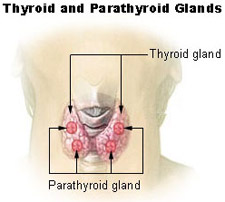 The thyroid gland is a very vascular organ that is located in the neck. It consists of two lobes, one on each side of the trachea, just below the larynx or voice box. The two lobes are connected by a narrow band of tissue called the isthmus. Internally, the gland consists of follicles, which produce thyroxine and triiodothyronine hormones. These hormones contain iodine.
The thyroid gland is a very vascular organ that is located in the neck. It consists of two lobes, one on each side of the trachea, just below the larynx or voice box. The two lobes are connected by a narrow band of tissue called the isthmus. Internally, the gland consists of follicles, which produce thyroxine and triiodothyronine hormones. These hormones contain iodine.About 95 percent of the active thyroid hormone is thyroxine, and most of the remaining 5 percent is triiodothyronine. Both of these require iodine for their synthesis. Thyroid hormone secretion is regulated by a negative feedback mechanism that involves the amount of circulating hormone, hypothalamus, and adenohypophysis.
If there is an iodine deficiency, the thyroid cannot make sufficient hormone. This stimulates the anterior pituitary to secrete thyroid-stimulating hormone, which causes the thyroid gland to increase in size in a vain attempt to produce more hormones. But it cannot produce more hormones because it does not have the necessary raw material, iodine. This type of thyroid enlargement is called simple goiter or iodine deficiency goiter.
Calcitonin is secreted by the parafollicular cells of the thyroid gland. This hormone opposes the action of the parathyroid glands by reducing the calcium level in the blood. If blood calcium becomes too high, calcitonin is secreted until calcium ion levels decrease to normal.
Parathyroid Gland
Four small masses of epithelial tissue are embedded in the connective tissue capsule on the posterior surface of the thyroid glands. These are parathyroid glands, and they secrete parathyroid hormone or parathormone. Parathyroid hormone is the most important regulator of blood calcium levels. The hormone is secreted in response to low blood calcium levels, and its effect is to increase those levels.Hypoparathyroidism, or insufficient secretion of parathyroid hormone, leads to increased nerve excitability. The low blood calcium levels trigger spontaneous and continuous nerve impulses, which then stimulate muscle contraction
Adrenal Gland
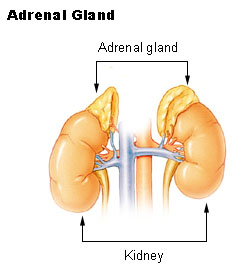 The adrenal, or suprarenal, gland is paired with one gland located near the upper portion of each kidney. Each gland is divided into an outer cortex and an inner medulla. The cortex and medulla of the adrenal gland, like the anterior and posterior lobes of the pituitary, develop from different embryonic tissues and secrete different hormones. The adrenal cortex is essential to life, but the medulla may be removed with no life-threatening effects.
The adrenal, or suprarenal, gland is paired with one gland located near the upper portion of each kidney. Each gland is divided into an outer cortex and an inner medulla. The cortex and medulla of the adrenal gland, like the anterior and posterior lobes of the pituitary, develop from different embryonic tissues and secrete different hormones. The adrenal cortex is essential to life, but the medulla may be removed with no life-threatening effects.The hypothalamus of the brain influences both portions of the adrenal gland but by different mechanisms. The adrenal cortex is regulated by negative feedback involving the hypothalamus and adrenocorticotropic hormone; the medulla is regulated by nerve impulses from the hypothalamus.
Hormones of the Adrenal Cortex
The adrenal cortex consists of three different regions, with each region producing a different group or type of hormones. Chemically, all the cortical hormones are steroid.Mineralocorticoids are secreted by the outermost region of the adrenal cortex. The principal mineralocorticoid is aldosterone, which acts to conserve sodium ions and water in the body. Glucocorticoids are secreted by the middle region of the adrenal cortex. The principal glucocorticoid is cortisol, which increases blood glucose levels.
The third group of steroids secreted by the adrenal cortex is the gonadocorticoids, or sex hormones. These are secreted by the innermost region. Male hormones, androgens, and female hormones, estrogens, are secreted in minimal amounts in both sexes by the adrenal cortex, but their effect is usually masked by the hormones from the testes and ovaries. In females, the masculinization effect of androgen secretion may become evident after menopause, when estrogen levels from the ovaries decrease.
Hormones of the Adrenal Medulla
The adrenal medulla develops from neural tissue and secretes two hormones, epinephrine and norepinephrine. These two hormones are secreted in response to stimulation by sympathetic nerve, particularly during stressful situations. A lack of hormones from the adrenal medulla produces no significant effects. Hypersecretion, usually from a tumor, causes prolonged or continual sympathetic responses.Pancreas—Islets of Langerhans

The pancreas is a long, soft organ that lies transversely along the posterior abdominal wall, posterior to the stomach, and extends from the region of the duodenum to the spleen. This gland has an exocrine portion that secretes digestive enzymes that are carried through a duct to the duodenum. The endocrine portion consists of the pancreatic islets, which secrete glucagons and insulin.
Alpha cells in the pancreatic islets secrete the hormone glucagons in response to a low concentration of glucose in the blood. Beta cells in the pancreatic islets secrete the hormone insulin in response to a high concentration of glucose in the blood.
Gonads
The gonads, the primary reproductive organs, are the testes in the male and the ovaries in the female. These organs are responsible for producing the sperm and ova, but they also secrete hormones and are considered to be endocrine glands.Testes
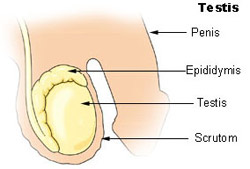
Male sex hormones, as a group, are called androgens. The principal androgen is testosterone, which is secreted by the testes. A small amount is also produced by the adrenal cortex. Production of testosterone begins during fetal development, continues for a short time after birth, nearly ceases during childhood, and then resumes at puberty. This steroid hormone is responsible for:
- The growth and development of the male reproductive structures
- Increased skeletal and muscular growth
- Enlargement of the larynx accompanied by voice changes
- Growth and distribution of body hair
- Increased male sexual drive
Ovaries
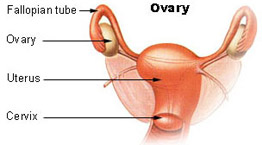
Two groups of female sex hormones are produced in the ovaries, the estrogens and progesterone. These steroid hormones contribute to the development and function of the female reproductive organs and sex characteristics. At the onset of puberty, estrogens promotes:
- The development of the breasts
- Distribution of fat evidenced in the hips, legs, and breast
- Maturation of reproductive organs such as the uterus and vagina
Other Endocrine Glands
In addition to the major endocrine glands, other organs have some hormonal activity as part of their function. These include the thymus, stomach, small intestines, heart, and placenta.Thymosin, produced by the thymus gland, plays an important role in the development of the body's immune system.
The lining of the stomach, the gastric mucosa, produces a hormone, called gastrin, in response to the presence of food in the stomach. This hormone stimulates the production of hydrochloric acid and the enzyme pepsin, which are used in the digestion of food.
The mucosa of the small intestine secretes the hormones secretin and cholecystokinin. Secreting stimulates the pancreas to produce a bicarbonate-rich fluid that neutralizes the stomach acid. Cholecystokinin stimulates contraction of the gallbladder, which releases bile. It also stimulates the pancreas to secrete digestive enzyme.
The heart also acts as an endocrine organ in addition to its major role of pumping blood. Special cells in the wall of the upper chambers of the heart, called atria, produce a hormone called atrial natriiuretic hormone, or atriopeptin.
The placenta develops in the pregnant female as a source of nourishment and gas exchange for the developing fetus. It also serves as a temporary endocrine gland. One of the hormones it secretes is human chorionic gonadotropin, which signals the mother's ovaries to secrete hormones to maintain the uterine lining so that it does not degenerate and slough off in menstruation.
1 comment:
Get Human nervous Glandular notes from here Human nervous Glandular
Post a Comment